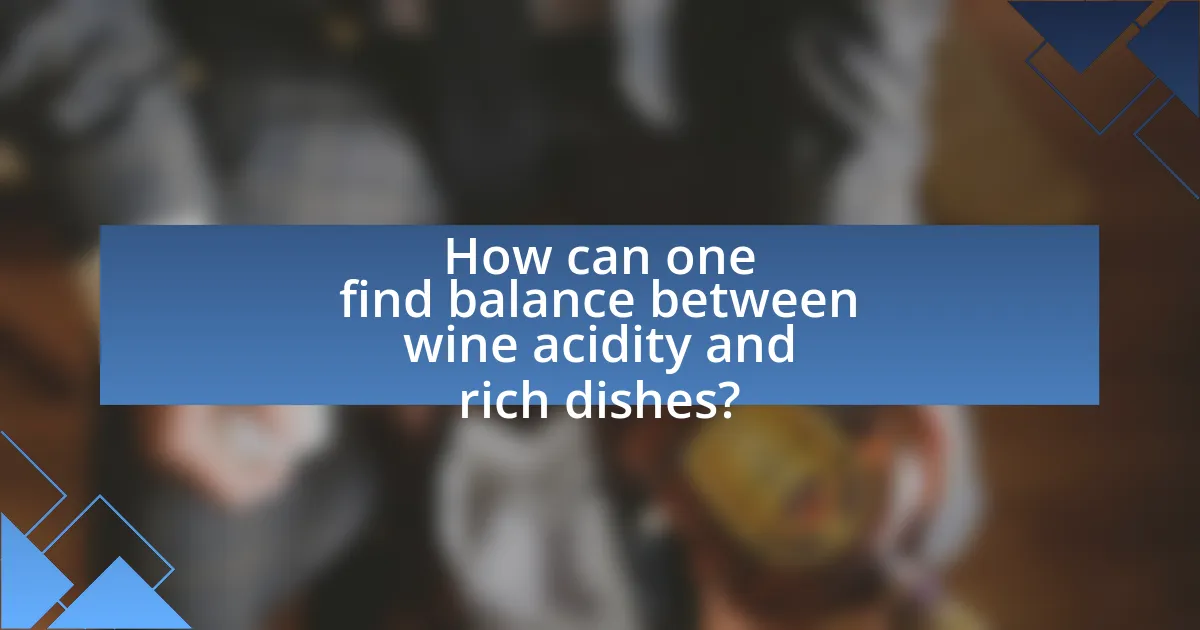The article focuses on the critical role of acidity in wine pairing, particularly in relation to rich dishes. It explains how high acidity in wines enhances balance and flavor, making them more compatible with fatty foods by providing a refreshing contrast. The piece details the different types of acidity found in wine, their influence on taste, and the importance of selecting wines with appropriate acidity levels to achieve harmonious pairings. Additionally, it discusses the consequences of neglecting acidity in wine pairing and offers practical tips for creating balanced meals that elevate the overall dining experience.

What is the role of acidity in wine pairing?
Acidity plays a crucial role in wine pairing by enhancing the overall balance and flavor profile of the meal. High acidity in wine can cut through rich, fatty dishes, providing a refreshing contrast that elevates the dining experience. For example, a crisp Sauvignon Blanc complements creamy sauces by balancing the richness with its acidity, making the dish more enjoyable. Studies have shown that wines with higher acidity can enhance the perception of freshness and brightness in food, leading to a more harmonious pairing.
How does acidity influence the taste of wine?
Acidity significantly influences the taste of wine by providing freshness, balance, and structure. Wines with higher acidity tend to taste crisper and more vibrant, enhancing the overall flavor profile. For example, white wines like Sauvignon Blanc and Riesling often exhibit pronounced acidity, which can make them more refreshing and food-friendly. In contrast, wines with low acidity may taste flat or dull. Research indicates that acidity also plays a crucial role in the aging potential of wine, as it helps preserve the wine’s integrity over time. Thus, the level of acidity directly affects the wine’s taste experience and its compatibility with various dishes.
What are the different types of acidity found in wine?
The different types of acidity found in wine include tartaric acid, malic acid, citric acid, and lactic acid. Tartaric acid is the primary acid in grapes and contributes to the wine’s stability and flavor. Malic acid, found in green apples, adds a crispness to the wine, while citric acid, present in citrus fruits, can enhance freshness. Lactic acid, produced during malolactic fermentation, softens the wine’s acidity and adds creaminess. Each type of acidity plays a crucial role in the overall balance and taste profile of the wine, influencing its pairing with rich dishes.
How does acidity affect the overall balance of wine?
Acidity is a crucial component that affects the overall balance of wine by providing freshness, structure, and a counterpoint to sweetness and bitterness. High acidity in wine enhances its crispness and liveliness, making it more refreshing and food-friendly, particularly when paired with rich dishes. For example, wines with higher acidity, such as Sauvignon Blanc or Chianti, can cut through the fat in creamy or oily foods, creating a harmonious balance on the palate. This balance is essential for a pleasant tasting experience, as it prevents the wine from feeling flat or overly sweet. Studies have shown that wines with balanced acidity are often rated higher in quality and preference during tastings, underscoring the importance of acidity in achieving overall wine balance.
Why is acidity important when pairing wine with food?
Acidity is important when pairing wine with food because it enhances the overall balance and flavor profile of the meal. High-acid wines can cut through rich, fatty dishes, providing a refreshing contrast that elevates the dining experience. For example, a Sauvignon Blanc, known for its acidity, complements creamy dishes by balancing the richness and preventing the palate from feeling overwhelmed. This principle is supported by the concept of flavor synergy, where the interaction between the acidity of the wine and the components of the food creates a more harmonious taste.
How does acidity enhance or complement rich dishes?
Acidity enhances or complements rich dishes by providing a counterbalance that cuts through the richness and fat, creating a more harmonious flavor profile. For instance, the acidity in a wine, such as a Sauvignon Blanc, can brighten a creamy dish like fettuccine Alfredo, making the overall experience more refreshing. This interaction occurs because acidity stimulates the palate, enhancing the perception of flavors and preventing the dish from feeling overly heavy. Studies in culinary science indicate that acidic components can elevate taste perception, making rich foods more enjoyable by adding complexity and contrast.
What are the consequences of ignoring acidity in wine pairing?
Ignoring acidity in wine pairing can lead to unbalanced flavors and an unpleasant dining experience. When acidity is overlooked, wines may clash with food, resulting in a lack of harmony; for example, a high-acid wine can enhance rich dishes, while a low-acid wine may make them taste flat or overly heavy. This imbalance can diminish the overall enjoyment of both the wine and the meal, as acidity plays a crucial role in cleansing the palate and enhancing the flavors of the dish. Studies show that wines with appropriate acidity levels can elevate the perception of taste, making the pairing more enjoyable and memorable.

How can one find balance between wine acidity and rich dishes?
To find balance between wine acidity and rich dishes, one should select wines with higher acidity to cut through the richness of the dish. Wines such as Sauvignon Blanc or Chianti, known for their bright acidity, complement fatty foods by enhancing flavors and providing a refreshing contrast. This pairing technique is supported by the principle that acidity in wine can enhance the perception of freshness and balance the richness of dishes like creamy pastas or fatty meats, making the overall dining experience more harmonious.
What characteristics define rich dishes?
Rich dishes are characterized by their high fat content, intense flavors, and often creamy or luxurious textures. These dishes typically include ingredients such as butter, cream, cheese, and fatty meats, which contribute to their richness. For example, dishes like beef stroganoff or creamy risottos exemplify this richness through their use of heavy sauces and decadent components. The presence of these ingredients not only enhances the flavor profile but also creates a satisfying mouthfeel, making the dish feel indulgent.
How do fat and richness in food interact with wine acidity?
Fat and richness in food soften the perception of wine acidity, creating a more balanced pairing. When fatty foods, such as creamy sauces or rich meats, are consumed, they coat the palate, which can diminish the sharpness of acidic wines. This interaction allows the acidity to enhance the flavors of the dish without overwhelming the palate. For example, a high-acid wine like Sauvignon Blanc can cut through the richness of a buttery dish, making the overall experience more harmonious. Studies in sensory analysis indicate that the combination of fat and acidity can elevate the enjoyment of both the food and the wine, as the acidity helps to cleanse the palate while the fat provides a smooth texture.
What are examples of rich dishes that pair well with acidic wines?
Examples of rich dishes that pair well with acidic wines include creamy pasta dishes, duck confit, and rich seafood like salmon or lobster. Creamy pasta, such as fettuccine Alfredo, benefits from the acidity in wines like Sauvignon Blanc, which cuts through the richness. Duck confit, with its fatty texture, is complemented by the acidity of a Pinot Noir, enhancing the dish’s flavors. Rich seafood, particularly salmon or lobster, pairs well with acidic whites like Chardonnay, as the acidity balances the dish’s richness and enhances the overall dining experience.
How can one assess the acidity level in wine?
To assess the acidity level in wine, one can use a pH meter or titration method. A pH meter provides a precise measurement of the wine’s acidity by determining its pH level, which typically ranges from 2.9 to 4.0 for wines, with lower values indicating higher acidity. The titration method involves adding a base to the wine until a neutral pH is reached, allowing for the calculation of total acidity in grams per liter. Studies show that wines with higher acidity levels tend to pair better with rich dishes, enhancing the overall dining experience.
What tasting techniques help identify acidity in wine?
To identify acidity in wine, tasters can use techniques such as the “sipping and swishing” method, where the wine is held in the mouth to assess its tartness and mouthfeel. This technique allows the taster to experience the wine’s acidity directly, as high acidity often results in a sharp, refreshing sensation that can cause salivation. Additionally, comparing the wine to known acidic wines, like Sauvignon Blanc or Riesling, can help tasters recognize acidity levels. Research indicates that acidity is a key component in wine structure, influencing flavor perception and balance, which is essential for pairing with rich dishes.
How does the region of origin affect wine acidity levels?
The region of origin significantly affects wine acidity levels due to variations in climate, soil composition, and grape varieties. For instance, cooler climates, such as those found in regions like Germany and the Loire Valley, typically produce wines with higher acidity because the grapes retain more natural acidity as they ripen slowly. In contrast, warmer regions, such as California and Australia, often yield wines with lower acidity due to faster ripening processes that lead to higher sugar levels and lower acid retention. Studies have shown that the pH levels of wines from different regions can vary widely, with cooler climate wines often exhibiting pH levels below 3.3, while warmer climate wines may exceed 3.5. This regional influence on acidity is crucial for wine pairing, particularly with rich dishes, as higher acidity can enhance food flavors and balance richness.

What are the best practices for pairing acidic wines with rich dishes?
The best practices for pairing acidic wines with rich dishes include selecting wines with high acidity to cut through the richness of the dish, ensuring a balance that enhances both the wine and the food. Acidic wines, such as Sauvignon Blanc or Chianti, complement fatty foods like duck or creamy sauces by providing a refreshing contrast that elevates the overall dining experience. This pairing principle is supported by the concept of balance in flavor profiles, where acidity acts as a palate cleanser, making each bite more enjoyable.
What tips can enhance the wine pairing experience?
To enhance the wine pairing experience, focus on balancing the acidity of the wine with the richness of the dish. High-acid wines, such as Sauvignon Blanc or Chianti, can cut through the fat of rich dishes like creamy pasta or fatty meats, creating a harmonious balance. Research indicates that acidity in wine enhances food flavors and can elevate the overall dining experience, as noted in studies by the American Journal of Enology and Viticulture.
How should one approach experimenting with different pairings?
To approach experimenting with different pairings, one should systematically test various combinations of wine and rich dishes while considering the acidity levels of both. This method allows for the identification of complementary flavors that enhance the dining experience. For instance, wines with higher acidity can cut through the richness of fatty dishes, creating a balanced palate. Research indicates that pairing acidic wines with rich foods can elevate the overall taste, as seen in studies highlighting the success of pairing Sauvignon Blanc with creamy sauces. By documenting the outcomes of each pairing, one can refine their approach and discover optimal combinations.
What common mistakes should be avoided in wine pairing?
Common mistakes to avoid in wine pairing include ignoring the wine’s acidity, which is crucial for balancing rich dishes. When pairing, many people overlook that high-acid wines can cut through the richness of fatty foods, enhancing the overall dining experience. Additionally, pairing wine with overly sweet dishes can lead to a clash, as the sweetness can overpower the wine’s flavors. Another mistake is choosing wines that are too heavy for lighter dishes, which can create an imbalance. Understanding these principles helps ensure a harmonious pairing that elevates both the wine and the food.
How can one create a balanced meal with wine and food?
To create a balanced meal with wine and food, one should pair wines with the appropriate acidity level to complement the richness of the dishes. For example, a high-acidity white wine, such as Sauvignon Blanc, can enhance the flavors of rich, creamy dishes by cutting through the fat, while a medium-bodied red wine with balanced acidity, like Pinot Noir, can harmonize with roasted meats. This approach is supported by the principle that acidity in wine can elevate the overall dining experience by providing contrast and enhancing the palate’s perception of flavors.
What role does acidity play in meal planning and preparation?
Acidity plays a crucial role in meal planning and preparation by enhancing flavors, balancing richness, and aiding in food preservation. High-acid ingredients, such as citrus fruits and vinegar, can brighten dishes, making them more palatable, especially when paired with rich foods like fatty meats or creamy sauces. For example, a study published in the Journal of Culinary Science & Technology highlights that acidity can elevate the overall taste experience by providing contrast and complexity, which is essential in creating harmonious wine pairings with rich dishes.
How can one adjust recipes to better suit wine pairings?
To adjust recipes for better wine pairings, one should focus on balancing the dish’s acidity with the wine’s acidity. For instance, incorporating acidic ingredients like tomatoes, citrus, or vinegar can enhance the pairing with wines that have higher acidity, such as Sauvignon Blanc or Chianti. This adjustment helps to create harmony between the dish and the wine, allowing the flavors to complement each other. Studies show that dishes with similar acidity levels to the wine enhance the overall tasting experience, making the food and wine more enjoyable together.


